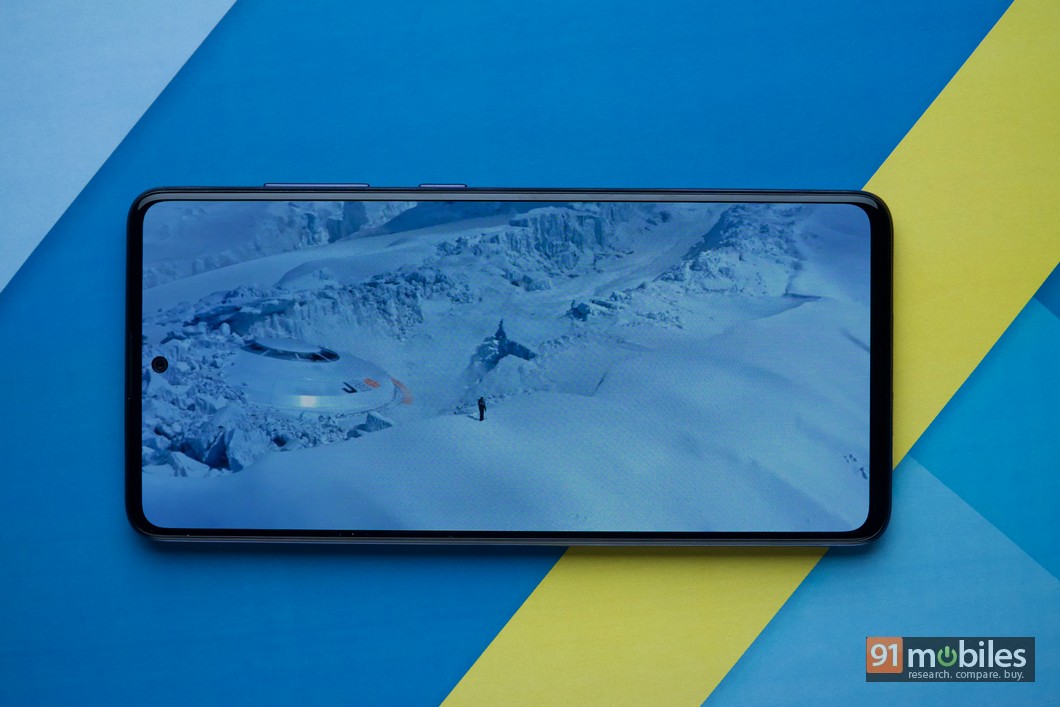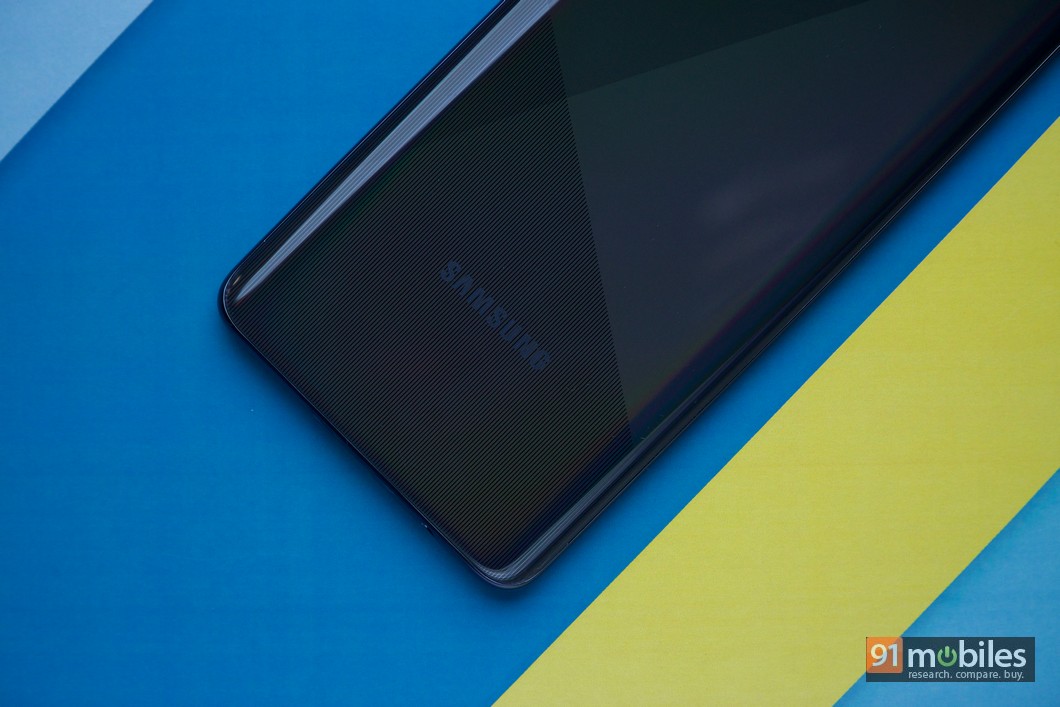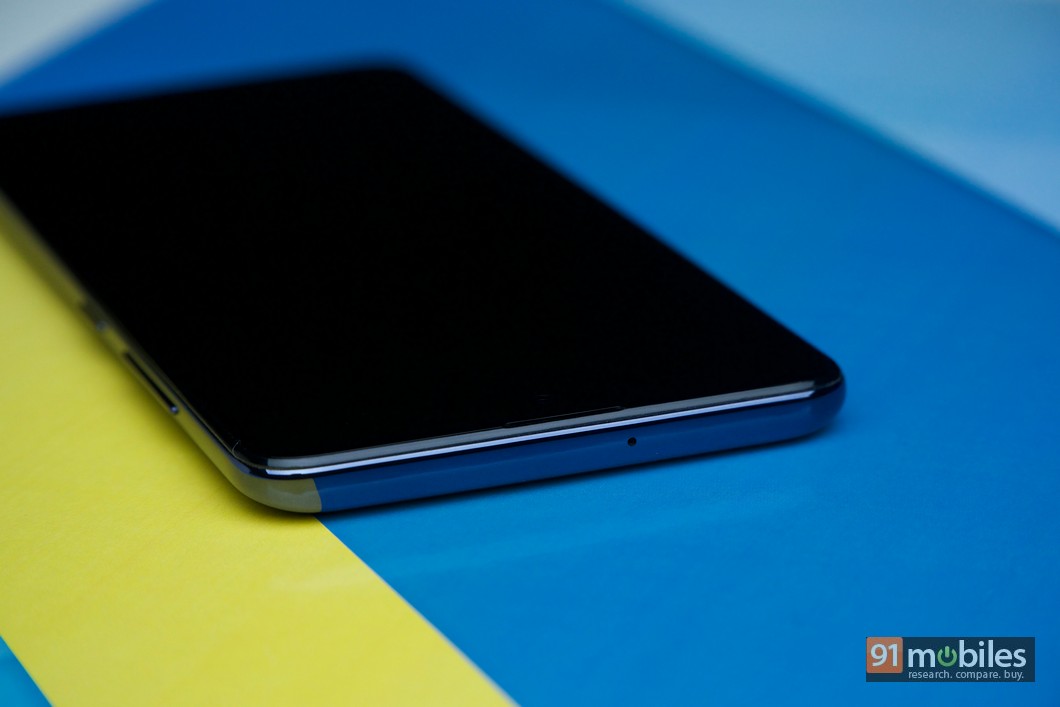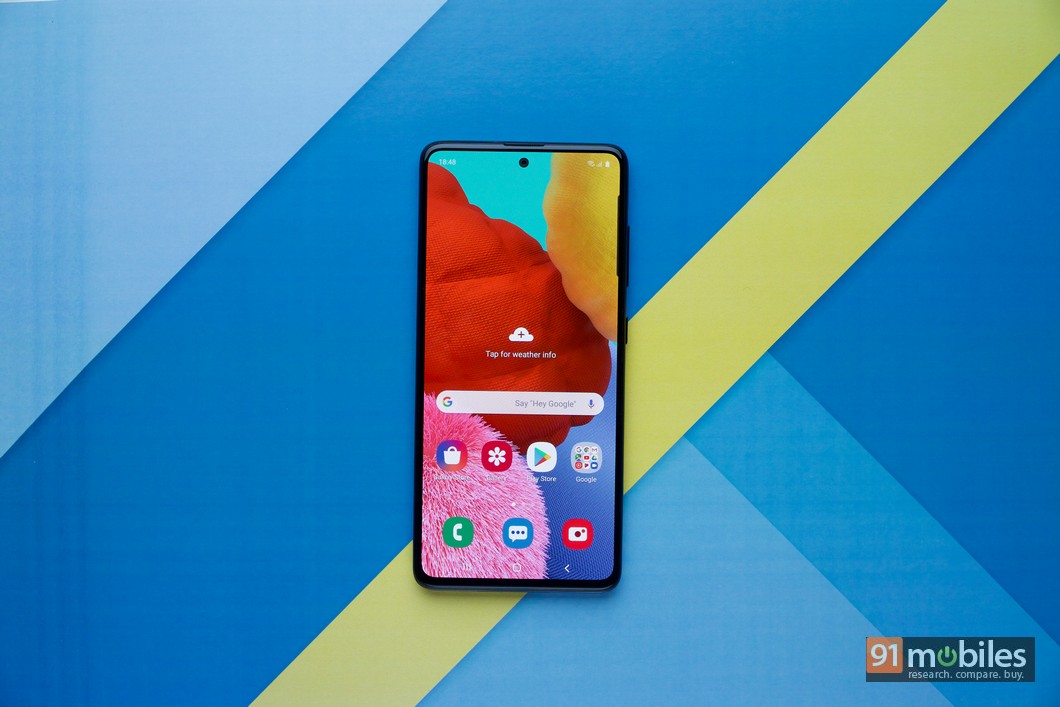Samsung had for long held the crown of the biggest smartphone maker in terms of shipments in India. In recent times though, its position has been challenged by Chinese brands. The budget and affordable smartphone segments in the country are being dominated by offerings that rock powerful specs and are priced attractively. As such over the past year, the South Korean electronics giant has been upping its budget and mid-range game, and increasing the value proposition offered by new phones in the Galaxy A and Galaxy M range. In fact, there was a period of time last year, when the brand launched a new smartphone in either of the series almost every week. Enter 2020 and we have the newest entrant in the A series. It comes in the form of the Galaxy A51, and takes over from the Galaxy A50 (review).

The Galaxy A50 was the company’s best selling smartphone last year (globally), so the Galaxy A51 has big boots to fill. Samsung used the A50 as a vehicle to introduce new technologies in its affordable lineup, such as the optical in-display fingerprint reader. With the A51, we get a new macro camera sensor, an upgraded 48MP primary camera setup and a punch-hole display, or as Samsung likes to call it, the ‘Infinity O’ display. Launched at Rs 23,999, the Galaxy A51 offers direct competition to Realme and Xiaomi’s offerings in the same bracket such as the Realme X2 (review) and Redmi K20 (review). I got my hands on the device and have been using it as my daily driver for some time. Here are my thoughts on why you should consider buying it.
Verdict
The Galaxy A51 is a compelling offering from Samsung, albeit seems priced on the higher side. Its stellar display and new India-centric software features help make it stand out, and is definitely worth a closer look… but not before also checking out the competition first.
Design and display
Samsung has been designing good-looking phones for a while now. The Galaxy A51 builds on the legacy with a unibody polycarbonate ‘glasstic’ finish that shimmers in rainbow colours when looked upon at different angles, very similar to the Galaxy A50. A firm grip is provided by the inward slanting of the edges which also lends a premium feel to this mid-range smartphone. On the back, the major visual difference from the previous-gen phone is the L-shaped camera array that sits in a rectangular bump, and has a new macro sensor included. However, if four cameras is the way to go forward from here on out, I quite like the Mate 30 Pro‘s matrix-like implementation. The glossy back has a way of becoming riddled with fingerprints so I recommend slapping on the clear plastic case that Samsung has very generously provided with the device.

As for the general in-hand feel, I believe that the A51 is quite easy to operate thanks to its slender frame and slightly reduced width as compared to other phones in its price point. Combine that with its weight of 172g and you’ve got yourself a phone which is quite easy to use with one hand. The volume rocker and power buttons are located on the right side of the phone, and are quite tactile and clicky. The left side of the device is barren, save for dual-SIM and microSD card slot on the top half. A headphone jack, a Type-C port and a speaker grille flank the phone’s bottom, a standard for the Galaxy A-series smartphones.

At the front, the new ‘Infinity O’ punch-hole display that has been introduced for the very first time on the Galaxy A-series forms the highlight. Like the Galaxy Note10 Plus (review), the cut-out for the selfie shooter is in the centre of the phone’s top. Personally, I believe that this type of implementation for the front camera is much better than any kind of teardrop notch or pop-up cameras. The reason is that the punch-hole is just a small blip and unobtrusive on an otherwise uninterrupted display, and as you continue to watch the screen, the hole just disappears.

Since this is a Samsung phone, I was quite sure that the display wouldn’t disappoint, and I was not wrong. With a 6.5-inch FHD+ AMOLED panel and an aspect ratio of 20:9 that seamlessly stretches side-to-side (albeit does not curve like the S-series phones), the viewing experience is bound to be amazing. As expected, the colour accuracy and brightness levels on the A51 are excellent. The viewing angles are great with the OLED bringing out deep blacks which compliment the vibrancy of the display. It will be hard, neigh impossible, to find this fine-tuned a display in the mid-range category, and is consequently the biggest advantage the A51 has. If I had to nitpick, it might be worthwhile to point out that you cannot change the colour temperature on the display. A higher refresh rate display might also be a cherry on top but that will not be a deal breaker since most phones in the segment don’t have this feature.

Pro Tip: Samsung Galaxy A51 misses out on the Glance lockscreen
With Glance on your smartphone, you can track the latest sports scores and news, get your daily astrology fix, play games, and even watch videos – without unlocking your smartphone. What’s more, Glance personalizes the content it shows on the lockfeed just for you, giving you content that you love to interact with every day.
Cameras
Quad cameras have been part of the A series since 2018 when Samsung released the Galaxy A9 (review) with four cameras on the back. Since then, Samsung has made big strides in the optics department, and that becomes pretty clear with the Galaxy A51. We see that the phone has a 48MP primary sensor with an f/2.0 aperture, a 12MP ultra-wide sensor with f/2.2 aperture and a 123-degree field of view, a 5MP depth sensor with f/2.2 aperture which has been retained from the Galaxy A50, and lastly a 5MP macro camera with f/2.2 aperture, which is a first for Samsung.

Moving first to daylight images using the primary sensor, we see vivid, crisp and detailed pictures which is expected since most of the subject is drowned in the sunshine. As is the trend, Galaxy A51’s primary shooter uses pixel binning to take four 12MP shots which are then stitched together to form one photo. In theory, this should deliver more details and better exposure. While this is partly true for the exposure part, I noticed no visible difference in the detailing of a shot that was clicked in normal mode versus the one in 48MP mode. You can, however, zoom in a lot more in a 48MP shot, but I believe that is of very little significance to most users. Apart from this, exposure calibration and dynamic range remains impeccable amongst most shots set in varied lighting conditions in the day.

Quite a few shots turned out to be worse on the ‘Night’ mode than if you had clicked it in normal mode. That being said, the night mode does bring out sharper details and definitely more exposure in extremely low-light environments.
The ultra-wide lens on the Galaxy A51 is nearly the same as the A50, with the only difference being increased resolution on the newer device. The 12MP snapper does a decent job of getting more in the frame than the primary lens, but it is at the cost of colour temperatures fluctuating. Details appear to be good enough for my liking, and better than the ultra-wide lenses on the Realme X2 and OPPO F15’s (review). The depth sensor has also been ported over from the A50 and its functionality is limited to accurate depth detection for good portrait shots.

Then there is the highlighting feature of the phone, which is the 5MP macro sensor, a feature which is becoming increasingly common on many mid-range smartphones and even a few budget ones as well. While I’m satisfied with the quality of macro shots, there is nothing spectacular to see. The macro lens suffers from more or less the same problems that many other OEMs also have, which is the ability to lose colour accuracy and detail. If there is plenty of light, then images are still usable, but as the light drops, things take a turn for the worse. Plus keeping your hand still at extremely close distances can be tough since there is no OIS.
Apart from that, the phone also possesses a 32MP selfie shooter housed in the punch hole. While the general quality of the selfies is not bad, overall sharpness seems to be lacking, along with spotty exposure handling. Portrait mode is about good enough on the front camera with the phone sometimes not able to separate my face from the background properly.
Performance and software
The Galaxy A51 uses the same Exynos 9611 chipset found in the A50s, and the chip is a slightly overclocked one than the Exynos 9610 seen on the Galaxy A50. While the performance was to my satisfaction, there are still the qualms of a mid-range phone. Medium to heavy tasks are performed well, with smooth app switching and multiple tasks running in the background. Heavy apps like Facebook and Instagram worked fine and also stayed open in the background for a long time owing to the 6GB of RAM. PUBG Mobile and CoD Mobile ran on high settings but it appears that the phone starts heating up quickly, which consequently results in high frame drops. I would recommend keeping the settings to medium.

As far as authentication goes, the Galaxy A51 happens to have an in-display fingerprint sensor which is slightly faster than the one seen on the Galaxy A50, but nowhere close to what a capacitive or ultrasonic fingerprint readers can do in terms of unlocking speed. The face unlock on the phone is also nothing to brag about, although it does work in very low light conditions as well. The call and microphone quality on the device were acceptable, but the bottom-firing speaker sounds rather tinny.

In terms of software, you get Android 10-based OneUI 2.0 which has looked to be incredibly similar to the previous version of OneUI. This is the first smartphone in 2020 which is shipping with Android 10 out-of-the-box. Regular features are all present in the phone such as privacy and location tools, a new Focus mode, enhanced parental controls, and navigation gestures. Overall, OneUI is one of the better Android skins out there and it has taken a lot of inspiration from stock Android by implementing an app drawer along with a more organised settings menu and a system-wide dark mode. However, Samsung still hasn’t dispensed with its significant amount of bloatware which includes double apps for the browser, gallery, and more.

There are, however, some India-centric features that Samsung has added on the Galaxy A51. The first one is called ‘Useful Cards’ which basically organises your SMS messages in a way that it becomes easy to find one. The messages will be stacked in cards which will be labelled accordingly. An example of these labels include Reminders and Offers. Then there is the multi-lingual typing feature of the keyboard, which detects if you are typing in Hindi and then offers next word suggestions accordingly in the same language. For example if I’m typing “Khaane mai kya..”, the AI will detect the language and provide next word suggestions like “bana rahe ho?”. The Finder feature allows the user to find content across entertainment, e-commerce, food and travel domains based on apps installed on your phone. This means that you can search for ‘The Irishman’ on the search bar (not the Google search bar) and the phone will direct you to Netflix. The last feature is called Smart Crop which basically allows the user to save, share or edit the most relevant part of a screenshot. So for example, if you have taken a screenshot of an Instagram post, Smart Crop will intelligently detect the image in the photo and crop it out for sharing.
Battery

The Galaxy A51 happens to have the same 4,000mAh cell that was seen on the Galaxy A50, and has the same charging speed as well ie. 15W. As far as testing metrics go, our standard battery drain test, which involves running a video in a loop continuously, lasted for about 15 hours which is pretty standard for a battery of this capacity. Real-world usage saw the phone making it through the day but barely. This involved most of my time connected to LTE while several of my social media accounts such as WhatsApp and Instagram always running in the background. There was some light video watching on YouTube as well but it was mostly on Wi-Fi. Throw in some gaming with it and you will quite likely have to charge the phone before the day ends. It isn’t bad per se but I really wish that Samsung used a higher capacity battery.
Final verdict

Samsung has come a long way from charging large sums of money for its mid-range smartphones to offering value-for-money propositions like the Galaxy A50. Consequently, it comes as little surprise that the South Korean giant is trying to build on the popularity of the A50. The best way to describe the Galaxy A51 is a jack of all trades. It ticks all the basic boxes, such as an exceptional display and decent cameras but it does fall slightly behind in terms of performance and battery.
What sets it back is its pricing which, in my opinion, is high compared to what the competition is offering. The Realme X2 starts in at only Rs 16,999 and has a quad-camera setup, a fast Snapdragon 730G chipset, and a decent enough battery. There is also an 8GB RAM variant for the Realme X2 which is currently unavailable for the A51, although the company should announce it soon. In my opinion, you should definitely give the A51 a try if you happen to be a Samsung fan or have been invested in the company’s ecosystem. The imminent launch of the POCO X2 might upstage it, but for now props to Samsung for trying to build a device that is likely to appeal to many.
Editor’s Rating: 3.5 / 5
Pros:
- Excellent display
- Great daylight performance
- OneUI 2.0 has made the software experience more refined
- Useful India-centric software features
Cons:
- Performance could’ve been better
- Macro lens is not great
- Average battery life
Photos by Raj Rout


































